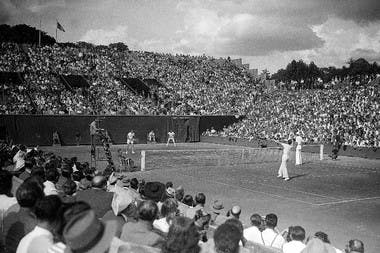 ©L'Equipe/Pressesports
©L'Equipe/Pressesports1946: a renaissance for Paris, and for Roland-Garros, after a 6-year hiatus due to World War II.
The tournament is not held be- tween 1940 and 1945 due to the war.
The war leaves its mark on Roland-Garros, which is finally held once again but in July, after the Wimbledon tournament. France’s Marcel Bernard wins the title at the age of 32, after originally not wanting to take part in the tournament. He finally signs up purely because his mixed doubles partner pulls out at the last minute. Down two sets to love in the final, he digs deep to turn things around and win the next three against Czechoslovakia’s Jaroslav Drobny. Bernard then goes on to win the doubles alongside Yvon Petra. In the women’s, Margaret Osborne defeats Pauline Betz in the final.
The Roland Garros stadium takes on a new look, with new stands built around Centre Court. Standing areas are also set up around the outside courts. Despite the intense heat, Hungary’s Jozsef Asboth becomes the first player from Eastern Europe to take the title, defeating South Africa’s Eric Sturgess in the final. Over in the women’s draw, Patricia Todd gets the better of fellow American Doris Hart. There is also a Roland-Garros juniors for the first time, with Belgium’s Jacky Brichant the first winner.
Due to the extreme heat the previous year, the tourna- ment goes back to its tradition- al dates and finishes on the first Sunday in June, when 32-year-old American Frank Parker defeats Jaroslav Drobny. After 1946, this was the second time that the Czech lost in the final of Roland-Garros. In the women’s singles, Americans Patricia Todd, Shirley Frey and Doris Hart are the favorites, but France’s Nelly Landry manages to take the title.
America’s Frank Parker becomes the first player to win Roland-Garros two years in a row. He retains his title courtesy of a win over Budge Patty in the final, while France’s Nelly Landry looks like she is going to emulate him only to lose to USA’s Margaret Osborne Dupont in the championship match.